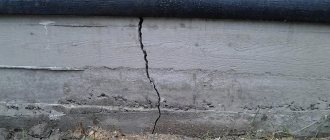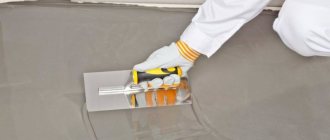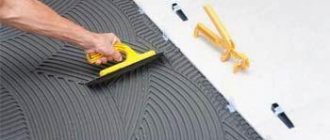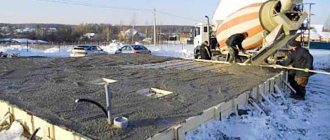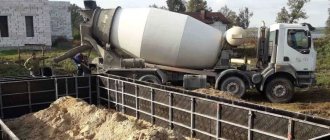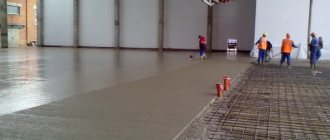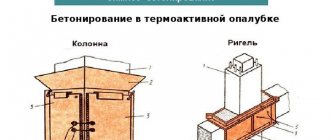The question of how long concrete takes to dry is of interest to any builder, since the duration of construction work depends on the time of setting and hardening of the mixture. Regardless of the type of object under construction, be it a temporary shed, a garage or a multi-story building, compliance with the hardening time allows you to create a structure that has standard strength parameters. If you know the exact curing time, you can competently plan construction processes and effectively optimize the construction time of buildings.
Stages of drying concrete mortar
Hardening of the solution occurs due to hydration, that is, a reaction that, after pouring, begins to occur between water and the binder components of the mixture. The essence of the chemical process is to convert the constituents of concrete into calcium hydrosilicate, which, after final drying, forms a monolithic base with high strength parameters.
To determine the time for complete hardening of concrete, it is important to understand that all reactions that occur in the composition are conditionally divided into two stages:
- Setting
occurs approximately an hour after mixing. During this period, the elements of the solution react, and the mixture itself begins to lose its mobile and plastic properties. - Hardening
- implies crystallization of the solution with a branded set of rigidity and strength. Hardening times depend on weather conditions, proportions and quality of the solution components.
Pouring technology
Regardless of the time of year, there are general rules for pouring the foundation. The work takes place in several stages, during which all technological details must be observed, taking into account the characteristics of the mixture.
Table 2. Filling sequence
| Description of work | Photo example |
| Before starting work, it is necessary to mark the area for the foundation and remove the top layer of soil. To mark the perimeter, drive in pegs and tighten the tape. And removing the top layer of soil in winter is a labor-intensive task. | |
| Digging a trench. The minimum digging level is 20–30 cm from the soil freezing level. Then, you need to make a sand cushion at the bottom and pour water for compaction. Before pouring, it is also necessary to lay a layer of waterproofing material. | |
| The next stage is reinforcement. Simply pouring even the highest quality concrete will not provide adequate foundation strength. Therefore, it is necessary to reinforce the structure with metal rods. The distance between parallel rods should not exceed 400 mm. | |
| Filling. The solution is prepared only before use or delivered in a concrete mixer. Filling must be done evenly around the entire perimeter. It is important to ensure that there are no voids. For compaction, it is best to use vibrating plates or other special units. |
After completing all the steps, it is necessary to give the mixture time to dry and achieve the required strength. It is during this period that you should monitor the amount of precipitation and frost. So that you have a clear idea of pouring a strip foundation, watch the video on the topic.
Video: how to pour a foundation in winter
How long does it take for concrete to set?
The setting stage of the solution lasts a short time. On average, for the most popular brands (M200, M300) it does not exceed 1 hour at a temperature of +20°C. If the temperature is lower, the time increases to 4–5 hours, and in hot weather, coupling may take no more than 20–30 minutes.
Builders need to take into account the hardening time of concrete, since the finished solution very quickly loses its plasticity. To avoid possible problems in the future, use the prepared mixture immediately after mixing. Often it is delivered to the construction site ready-made in special concrete mixers, which do not stop mixing even during transportation.
Time, description of the hardened layer, temperature gradient and hardening rate
Solidification of a steel ingot.
Some quantitative relationships.
Time, description of the hardened layer, temperature gradient and hardening rate
The Stefan-Fields law is well known : X=K√τ , where X is the thickness of the hardened layer, K is the solidification coefficient, τ is the time elapsed from the beginning of solidification. This law works for stearin, water, pure metals and steel, if you correctly understand what steel is and choose the right K value
Fig. 1 Diagram of the structure of a solidifying steel ingot)
Steel, like most real alloys of the solid solution type, hardens in the temperature range liquidus - solidus, having a real extension (W) equal to the distance between the liquidus and solidus isotherms : W = NL - HS
HL = KLτ1/2 HS = KSτ1/2 W = (KL – KS) τ1/2 = ΔK τ1/2 ΔK = 0.25 – 0.65 mm/s1/2,
on average - 0.4 mm/s1/2
τ – time from the beginning of solidification, s
Thus, the width of the two-phase zone, the “swamp,” increases as solidification progresses deeper into the ingot. After 100 seconds after the start of hardening, its width is only 4 mm, after 3 hours - 40 mm, after 11 hours - 80 mm, after 25 hours - 120 mm. At the same time, in an ingot with an inscribed average diameter of 2000 mm (weight about 60 tons), the liquidus lines have already closed and the axial zone with a diameter of 250-300 mm is a swamp.
The features of the solidification process depend specifically on the two-phase zone, on the temperature gradient G within this zone. G= (TL – TS)/(HL – HS) = ΔT/W
The value of the intercritical interval can be determined from empirical multiple regression equations:
TL= 1537 – 88(%C) – 30(%P) – 25(%S) – 18(%Ti) – 8(%Si) – 5(%Mn) – 5(%Cu) – 4(%Ni ) – 2(%Mo) – 2(%V) – 1.5(%Cr)
TS= 1535 – 200(%C) – 183.9(%S) – 124.5(%P) – 12(%Si) – 6.8(%Mn) – 4.3(%Ni) – 4, 1(%Al) – 1.4(%Cr), from which the value is determined
ΔT = 2+112(%C) + 159(%S)+ 4(%P)+4.3(%Si)+4.1(%Al)+1.8(%Mn)+0.3( %Ni)+0.1(%Cr) -18(%Ti) – 2(%Mo+V)
Obviously, depending on the composition of the steel, ΔT varies from 15 to 2000K, and W is the width of the swamp from 15 to 250 mm (in extra-large ingots). Accordingly, the gradient value can vary from tens of K/mm to fractions of K/mm.
If we take ΔK=0.4mm/s1/2, then W=0.4√τ,mm,
τ = X/K
from the equation X = Kτ1/2 (Stephen-Fields law), where x is the thickness of the metal layer hardened during time τ, the pourability isotherm, usually it is located approximately half the distance between the liquidus and solidus isotherms
K – solidification coefficient, determined by pouring ingots and castings.
K = 1.4 – 1.7 cm/min1/2 during the period of filling the ingot
K = 2.5 – 2.7 cm/min1/2 = 3.23 mm/s1/2 – 3.5 mm/s1/2 during the solidification period of the filled ingot
K = 2.4 – 2.9 cm/min1/2 = 3.1 – 3.75 mm/s1/2 for continuously cast billets.
Then: W = 0.4(X/K), G=2.5ΔT*K/X 0/mm
For low-alloy structural steels G=(160….210)/Х
The product of the gradient and the rate of advancement of the solidification isotherm represents the cooling rate in the intercritical interval.
Hardening processes
Hardening is a longer process, lasting on average up to 28 days. Immediately after setting, the solution still remains soft, but already becomes immobile. Gradually it undergoes crystallization and acquires the necessary rigidity indicators. The strength gain is determined according to the graph or using the formula:
Rn = R28(lgn/lg28), where:
- Rn – solution strength;
- n – time that has passed since pouring the mixture (in days);
- R28 – brand of building material.
Strength parameters are determined only from the third day from the moment of mixing. When figuring out how long concrete hardens, special attention is paid to the 7th and 28th days. On average, after 14 days from filling, Rn reaches 70%.
Curing period
In order to best understand the entire process and estimate its duration, let's start with the composition of concrete and the processes occurring in it.
Structure
Everything ingenious is simple.
So in the case of concreting, absolutely accessible ingredients are taken to mix the required solution:
- Sand . Quarry sandstone serves as an excellent means of reducing the porosity of the finished material.
Photo of a sand quarry
- Gravel . Determines the level of strength of the future concrete structure, which can only be damaged by diamond-coated nozzles.
Cutting reinforced concrete with diamond wheels is the only way to achieve high-quality processing
- Water . Acts as a dispersed medium to combine all the elements used and, coming into contact with cement, allows it to harden.
Tip: after pouring the solution, it is recommended to cover it with plastic wrap and water it until it hardens completely. This will significantly improve its strength characteristics.
Protect concrete from premature drying out
- Cement . It is an astringent substance, which, as we noted above, in combination with water turns into a durable stone and combines all other components. It is on this that the hardening time of concrete depends to the greatest extent.
Advice: it is recommended to use only the highest quality cement of the M400 and M500 brands. Although the price of such mixtures is higher, only they can ensure the proper level of setting of the solution.
Five hundred mark is the best choice for creating a foundation
Positive influence factor
So, we understand the structure of concrete and the processes occurring in it. If the kneading is done correctly, what can affect its hardening time? At the beginning of the article there is a graph of the dependence of solution maturation on temperature. Below is a similar table, only taking into account the average daily indicators:
Table of concrete hardening time depending on the average daily temperature
As you can see, the level of heat is essentially the only factor influencing how long it takes concrete to harden. The more degrees above zero, the faster the composition will gain its strength, but due to the fact that the temperature changes during the day and it is impossible to achieve a single constant indicator, a period of 28 days would be the ideal option.
The first setting occurs in the first seven days, which is 70 percent of the total strength of concrete. But the maximum result is gradually gained over the next three weeks. And then, as we noted earlier, only diamond bits can damage the finished product.
Diamond drilling of holes in concrete is the only processing method
Negative influence factor
It's still the same temperature, only negative. The instructions prohibit concreting in winter, when frost is possible. This occurs as a result of the fact that the water freezes and does not react with the cement, eliminating the process of petrification. And even moreover, when it crystallizes, it expands and destroys the structure of concrete from the inside.
As a result, even if the surface of the structure seems strong enough, after the liquid thaws you will get a loose substance that is useless for anything. Thus, it is either worth laying concrete in the summer, or taking care of heating it yourself at sub-zero temperatures.
To do this, you can use the following methods:
- Add an antifreeze additive to the solution, which will prevent the water from freezing in winter.
Sample of frost-resistant additive
- Provide concrete heating with an electric wire, which helps maintain an acceptable temperature for the entire solution.
Heating cable in action
Acceleration
It is also worth mentioning special modifiers, which, when added to concrete during the mixing process, can significantly improve its properties, including shortening the hardening period. Some additives can reduce this time to a week, which will allow you to remove the formwork in the first days, and after the specified period, begin subsequent construction work.
An example of a modifier that accelerates the setting period of concrete
Temperature
The optimal temperature for drying the solution is +20…+22°C. The higher it is, the faster the mixture sets and hardens. If the thermometer reads 0°C or below, hydration stops. In such a situation, builders have to use artificial hardening methods, for example, adding potassium chloride or turning on heat guns. In extreme heat, it is necessary to increase the humidity of the concrete, otherwise the moisture from the mixture will quickly evaporate and, as a result, a chemical reaction will not begin.
To figure out how long it takes for a concrete screed to dry outside at different temperatures, check out the table.
| Solution temperature, °C | Hardening time, days | ||||
| 3 | 5 | 7 | 14 | 28 | |
| 50 | 70 | 84 | 95 | – | – |
| 40 | 64 | 75 | 85 | – | – |
| 30 | 57 | 68 | 76 | 95 | – |
| 20 | 50 | 60 | 69 | 87 | – |
| 10 | 42 | 51 | 59 | 75 | 91 |
| 0 | 31 | 39 | 46 | 61 | 77 |
Concrete grade
The process of setting and hardening is largely influenced by the components of the mixture and their proportions. In particular, the more porous materials in the solution, the slower the evaporation of moisture will be. The main factor in the hydration time is the grade of concrete. The lower it is, the less intense the strength gain of the building material. Although heavier grades harden faster, in any case it is recommended to keep the finished solution for at least 28 days before loading.
Let's look at how long it takes for the most popular brands of concrete to harden.
| Brand | Brand strength, % | Maximum strength, kgf/cm² | Curing time, days |
| M400 | 100 | 196,45 | 25 |
| M300 | 60 | 360,18 | 14 |
| M200 | 30 | 392,9 | 3 |
What does a violation of exposure time lead to?
Builders are advised to fully maintain the drying time of the mortar. If you put stress on it ahead of schedule, this can lead to a number of problems in the future:
- The appearance of cracks
- this is especially true for the foundations of buildings, which can be subject to fracture along the entire height. Often cracks appear not only in the foundation, but also in the ceilings or walls, and they are often through. To avoid troubles with the foundation, it is important to know how long concrete hardens in the ground. As a rule, the formwork is removed no less than 2 weeks after it is poured, otherwise the structure may be damaged. - Deformation
– common problems associated with insufficient concrete curing time include deformation processes in the foundation, cracking of the floor screed, and the formation of chips or dents on the walls. - Damage to finishing
- occurs after interior or exterior finishing work. For example, if a house was built from unseasoned aerated concrete, then plaster may fall off the walls or wallpaper may peel off. If the floor screed in the bathroom does not have enough time to harden, ceramic tiles may subsequently peel off from it.
How to speed up the drying of the mixture
If construction deadlines are tight, that is, it is not possible to wait for final hardening or it is not possible to ensure optimal humidity and temperature, it is permissible to use methods that help speed up hardening. These include:
- heating the solution at low air temperatures (steam, electricity, etc.);
- the use of additives to accelerate hardening;
- laying polyethylene on the surface, which retains the heat generated during hydration.
Carrying out construction work using concrete requires a special approach at each stage. If you approach the drying time of the mixture correctly, you can achieve increased strength of the building and avoid troubles associated with its deformation due to insufficient curing.
Author of the article
Winter work – construction at low temperatures
At low temperatures, hydration does not accelerate, but slows down, as a result of which the foundation does not have time to gain the strength it needs. At zero degrees, the hardening process of the solution in the outer layer stops completely, and inside the structure it continues for several hours until all components have cooled. In this case, water does not have time to react with cement, after which it freezes, increases in volume and literally breaks the structure of the concrete.
Winter construction work
Experts are well aware of the temperature at which concrete can be poured for a foundation without fear of losing its performance. Frosts are a significant obstacle to concreting, so in winter specialists are forced to use special technologies and means:
- warming up concrete elements before pouring and heating the formwork;
- laying a heated cable inside a slab or strip foundation;
- supplying electric current to the reinforcement frame elements for heating;
- installation of heaters around the foundation for the first three days;
- creating a greenhouse by covering the entire perimeter of the foundation with film;
- introduction of special reagents into the mixture that reduce the crystallization temperature of water or accelerate the hardening time of the foundation.
The use of any of the described technologies significantly increases the cost of foundation construction. Therefore, it is difficult for private owners to recommend the above funds. There are other ways to pour concrete at sub-zero temperatures. One of them is changing the amount of water and cement in the prepared solution. It requires the most accurate and competent dosage of the mixture components used. At home, it is almost impossible to calculate the required amount of water and cement to improve the hardening of the foundation in winter.
Warming up the concrete
In winter, it is recommended to use Portland cements with an increased hardening rate. They contain the letter R in the marking. The technology of their use involves:
- heating two-thirds of the water for the solution to a temperature of about 70 degrees Celsius;
- adding sand and gravel to the water;
- adding the remaining third of water and cement to the mixture.
The solution must be mixed twice as long as usual. The vibration compaction time also increases by 1.5 times. Before pouring the solution, the formwork must be checked for the presence of ice, snow removed and the underlying layer warmed up. Cover the poured solution with a polymer film, which will keep the mixture warm for some time. If the given rules for concreting a foundation cannot be followed at home, it is recommended to wait until the air temperature rises above +5 degrees. If the forecast for the next three weeks is favorable, the home owner will be able to fill using standard technology.
